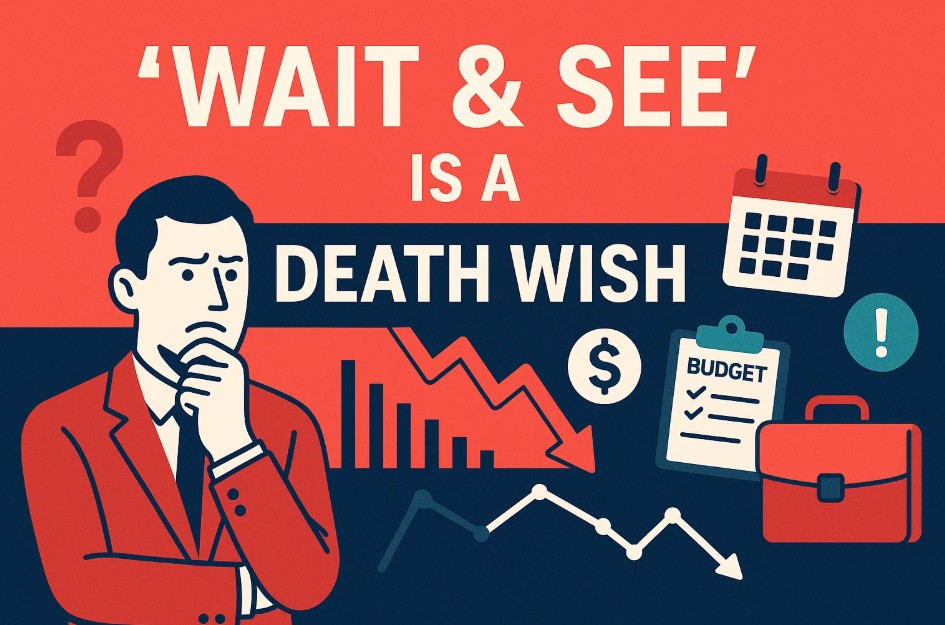Economic downturns are inevitable… but your response doesn’t have to be.
Since 2000, the U.S. economy has experienced a major downturn or disruption roughly every 5 to 6 years. From the dot-com crash to COVID-19 to current inflationary pressures, the impact is always real, even if it looks different every time.
Sometimes it’s a crash.
Sometimes it’s a freeze.
Other times, it’s just that gnawing, uncomfortable feeling that something bad is coming.
And in those moments, most businesses respond in one of two ways:
- They freeze entirely.
- They start cutting without a plan.
Both are costly.
Neither is a strategy.
You don’t outlast chaos by panicking. You outlast it by knowing exactly what drives revenue—and making fast, intentional decisions to preserve it.
Contents
“Wait and See” Is Not (And Never Will Be) a Strategy
Every time a recession looms, we hear the same phrase:
“Let’s wait and see what happens.”
We see it constantly when pitching our services. It’s a reflex for business owners, CMOs, and even experienced sales leaders. And look—we get it. When the economy wobbles, the instinct is to pause all spending and hope for clarity.
But let’s be real: “wait and see” is a risk, not a plan.
What are you actually waiting to see?
Revenue tanking? A pipeline that flatlines?
During COVID, we saw the impact in real time. Many businesses hit pause on their marketing spend, hoping things would stabilize. Six months later, they had fewer clients, tighter cash flow, and no momentum.
The businesses that thrived during the chaos? They doubled down.
They refined their messaging, optimized their outreach, and held every dollar accountable.
That’s what smart crisis decision-making looks like.
What to Keep: Revenue Engines and Smart Scaling
When everything’s uncertain, smart leaders move quickly and focus on impact.
Here’s what should stay:
Direct revenue engines
Outbound, inbound, SDRs, and appointment setting—anything that brings in business.
Scalable systems
CRM automation, sales enablement tech, and operations that grow with you.
Engaged client accounts
Focus on the ones showing signs of life. Lean in where you’re seeing traction.
Retention infrastructure
Think onboarding workflows, success metrics, renewal playbooks—anything that protects your existing revenue base.
If it fuels growth, funds operations, or secures your current clients, you keep it.
This is the core of crisis budgeting: don’t cut oxygen when you can cut fat.
In uncertain times, one thing should never go on pause: your ability to generate qualified sales conversations. Our B2B appointment setting services give you a turnkey outbound engine—built for consistency, scale, and real results.
What to Cut: Dead Weight, Distractions, and Ego Spend
Let’s not sugarcoat it—some parts of your business won’t make sense in a downturn.
Here’s a framework for smart cuts:
- Tier 1: Ego Spend: Swag, fancy SaaS tools, and vanity perks. These go first.
- Tier 2: Redundancies: Duplicate roles, unused software, overlapping tools—consolidate ruthlessly.
- Tier 3: Non-core functions: Internal departments that aren’t essential to delivery. These are great candidates for outsourcing.
During the 2020 downturn, companies that outsourced non-core functions recovered 29% faster than those that didn’t (source: Deloitte).
Smart businesses don’t slash. They streamline.
If your company does HVAC, you don’t outsource the install team. That’s the product.
But do you really need a five-person in-house marketing department? Probably not.
A Crisis Decision-Making Framework: 4 Moves to Make Right Now
If you’re staring at budget cuts, don’t panic—prioritize. Here’s a quick framework to help you navigate your next move:
1. Follow the Money
Break your revenue down by:
- Client
- Industry
- Payment behavior
Ask: Who’s still paying? Who’s gone quiet?
If 30% of your ARR is sitting with clients “waiting for Q3 to stabilize,” that’s not a forecast—that’s a risk.
2. Run a Lean Ops Audit
Ask: What’s actually producing outcomes?
If a team, tool, or process doesn’t directly support revenue, retention, or scalability, it’s probably dead weight.
Deloitte found that 70% of execs listed cost reduction as their #1 reason for outsourcing during crisis conditions.
3. Define Core vs. Non-Core
Mission-critical functions stay. Everything else? See if it can be streamlined, automated, or outsourced.
If your core value is sales execution, you shouldn’t be burning payroll on facilities management or internal reporting.
4. Keep Selling. Period.
This is the one non-negotiable: don’t stop selling.
The businesses that weather downturns are the ones that keep the pipeline warm—even when spending feels uncomfortable.
The only thing worse than cutting too late is going quiet on your prospects.
Final Thoughts
Here’s the brutal truth: downturns always cost you something.
You’ll either:
- Pay now—with smart, surgical decisions that protect your revenue engine
- Or pay later—rebuilding from scratch while your competitors sprint ahead
If you’re still clinging to “wait and see,” you’re already behind. The companies that win during chaos aren’t the ones that get lucky. They’re the ones that move quickly, double down on what works, and make bold decisions when everyone else flinches.

Madison Hendrix
Madison has worked in SEO and content writing at Abstrakt for over 5 years and has become a certified lead generation expert through her hours upon hours of research to identify the best possible strategies for companies to grow within our niche industry target audiences. An early adopter of AIO (A.I. Optimization) with many organic search accolades - she brings a unique level of expertise to Abstrakt providing helpful info to all of our core audiences.
- Madison Hendrix#molongui-disabled-link
- Madison Hendrix#molongui-disabled-link
- Madison Hendrix#molongui-disabled-link
- Madison Hendrix#molongui-disabled-link








